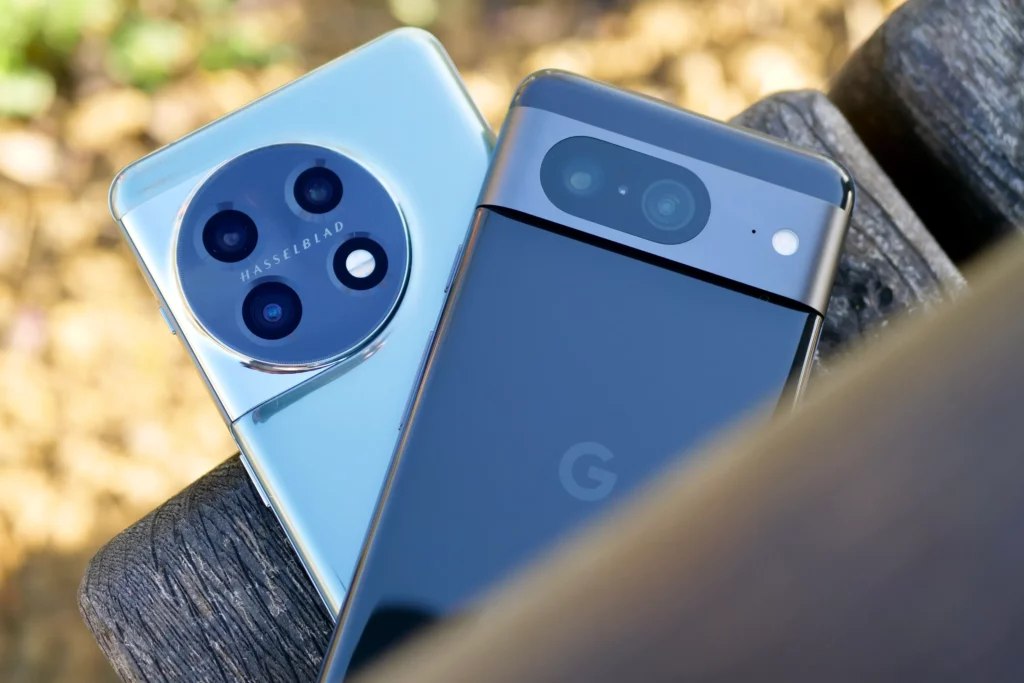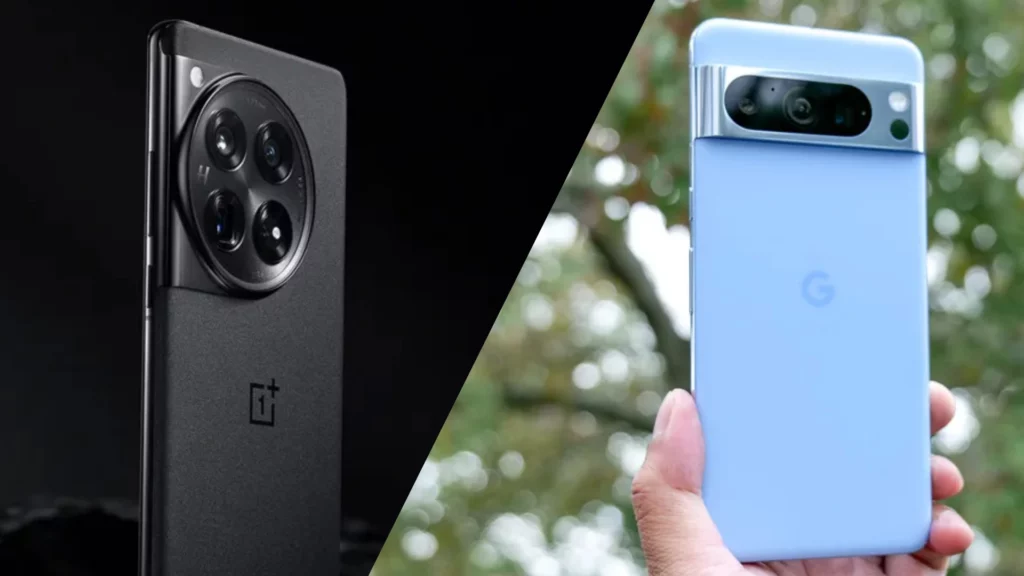OnePlus recently celebrated its 10th anniversary with the launch of the OnePlus 12, the company’s 11th flagship series. With impressive hardware, lightning-fast wired and wireless charging, and an impressive display, the OnePlus 12 made released in China.
As people eagerly wait for the global launch, the OnePlus 12 is set to confront its rivals like the Pixel 8 Pro and the Apple iPhone 15 series in the United States. Particularly, the Pixel 8 Pro emerges as a satisfying option for those seeking a feature-rich Android smartphone. If you’re eyeing an early 2024 purchase, a comparison between the OnePlus 12 and the Pixel 8 Pro might just help you with your decision-making process.
OnePlus 12 vs. Pixel 8 Pro: Specs Showdown
Size and Weight:
- OnePlus 12: Measures 164.3 x 75.8 x 9.2mm and weighs 220 grams.
- Pixel 8 Pro: Sized at 162.6 x 76.5 x 8.8 mm and weighs 213 grams.
Screen Technology:
- OnePlus 12: Features a 6.82-inch LTPO OLED display with a resolution of 1440 x 3168 pixels, boasting HDR10+ and a peak brightness of 4,500 nits.
- Pixel 8 Pro: Offers a slightly smaller 6.7-inch LTPO OLED display with 1344 x 2992 pixels, supporting HDR10+ and reaching a peak brightness of 2,400 nits.
Operating Systems:
- OnePlus 12: Runs on OxygenOS 14 based on Android 14, focusing on a refined and customizable Android experience.
- Pixel 8 Pro: Utilizes Google’s tailored Android experience, ensuring seamless integration with Google services and extended software support.
Processor Capabilities:
- OnePlus 12: Employs the Qualcomm Snapdragon 8 Gen 3 chipset, showcasing significant improvements in CPU, GPU, and AI capabilities.
- Pixel 8 Pro: Utilizes the Google Tensor G3 chipset, emphasizing AI capabilities and refined camera features.
Camera Setups:
- OnePlus 12: Boasts a triple rear camera system with a 50MP primary sensor, a 48MP ultrawide, and a 64MP periscope telephoto, enhanced by Hasselblad color science and Dolby Vision video recording capabilities.
- Pixel 8 Pro: Features a similar triple rear camera setup with a 50MP primary sensor, a 48MP periscope telephoto, and advanced AI-based imaging enhancements.
Charging Speeds and Battery:
- OnePlus 12: Offers exceptional charging speeds with 100W wired fast charging and 50W wireless charging, powered by a 5,400mAh battery.
- Pixel 8 Pro: Presents decent charging speeds with 33W wired and 23W wireless charging, housing a 5,050mAh battery.
By studying these specifications carefully, it’s evident that both the OnePlus 12 and Pixel 8 Pro showcase their strengths in different areas, helping users with diverse priorities. The OnePlus 12 emphasizes superior display quality, rapid charging, and a robust camera system, while the Pixel 8 Pro banks on Google’s AI technology, a refined Android experience, and a balance between battery capacity and charging speeds.

Design and Build Quality
Indeed, the OnePlus 12 meets the design legacy established by its predecessor, the OnePlus 11, with a few subtle modifications. OnePlus 12 features minor refinements such as slight adjustments to the camera bay, potentially accommodating a larger telephoto setup. Additionally, the positioning of the alert slider has shifted from the right edge to the left edge of the phone, offering a new placement for user convenience. These alterations maintain continuity within the OnePlus design principles while providing subtle enhancements to the device’s functionality and aesthetic appeal.
In contrast to it, the Pixel 8 Pro showcases a more strong design with the use of Gorilla Glass Victus 2 for high durability. This reinforcement can be seen across the front and back panels, elevating the device’s resilience against accidental drops or impacts. Additionally, the Pixel 8 Pro integrates stainless steel frames that run along the camera bump, further increasing its structural integrity and offering increased protection in case of falls.
Display and Visual Experience
The OnePlus 12 has a large AMOLED panel higher in resolution compared to the Pixel 8 Pro. With a 6.82-inch display featuring a remarkable 1440 x 3168 pixel resolution, the OnePlus 12 aims to deliver an immersive visual experience. Additionally, the device has outstanding brightness levels, with peak brightness reaching up to 4,500 nits, promising exceptional visibility even in highly bright conditions. Also, the OnePlus 12 introduces eye strain reduction measures, such as a high pulse-width modulation (PWM) frequency of 2,160Hz, aimed at minimizing eye fatigue, especially in low-light scenarios. However, the validity and effectiveness of these claims might require further testing and validation from relevant authorities.
Conversely, the Pixel 8 Pro offers a slightly smaller 6.7-inch display but still provides a vivid and bright viewing experience. While its resolution of 1344 x 2992 pixels is slightly lower than that of the OnePlus 12, the Pixel 8 Pro matches it with vibrant color reproduction and bright visuals. Despite the lower resolution, the Pixel 8 Pro maintains an impressive peak brightness of 2,400 nits, ensuring good visibility in various lighting conditions. However, it’s important to note that the Pixel 8 Pro is limited in HDR support, offering HDR10+ but lacking Dolby Vision, potentially impacting the device’s performance with certain HDR content.
Performance and Processing Power
The OnePlus 12 has the Qualcomm’s Snapdragon 8 Gen 3 chipset, positioning itself as an early adopter of this powerful hardware. This chipset promises substantial improvements in processing power, AI capabilities, and overall performance. The Snapdragon 8 Gen 3 offers a revamped CPU configuration, boasting one prime core, four performance cores, and two efficiency cores, resulting in a 30% boost in CPU and 25% enhancement in GPU performance compared to its predecessor. Moreover, it emphasizes advancements in AI-related functionalities, such as a 98% boost in neural processing and faster processing using generative AI models, enabling various on-device AI applications without relying on external data centers.
In contrast, the Pixel 8 Pro houses Google’s Tensor G3 chip, a custom-designed processor crafted in collaboration with Samsung. The focus of this chipset revolves around leveraging refined AI features to elevate the device’s overall performance, particularly in the realm of camera capabilities. Google’s Tensor G3 chip empowers the Pixel 8 Pro with dedicated AI capabilities, enhancing functions such as imaging, photo processing, and AI-powered camera features like Magic Editor and Best Take. Additionally, it enables improved security features such as Face Unlock, utilizing AI for facial recognition without specialized sensors.
Battery Life and Charging Speeds
The OnePlus 12 stands out prominently with its outstanding charging capabilities, setting a high bar in the smartphone market. With an impressive 100W wired charging and 50W wireless charging support, OnePlus has prioritized ultra-fast charging speeds as a key feature. This exceptional charging technology promises users the convenience of significantly reduced charging times, allowing the device to attain a full charge in an amazingly short duration. This emphasis on rapid charging aligns with OnePlus’s commitment to providing users with a quick and hassle-free charging experience, ensuring their devices are ready to go in minimal time.
On the other hand, while the Pixel 8 Pro may lag slightly behind in terms of charging speeds compared to the OnePlus 12, it compensates with a respectable battery capacity. Despite not boasting the lightning-fast charging rates of the OnePlus 12, the Pixel 8 Pro offers a decent battery size, ensuring a reliable and enduring power source to sustain daily usage without frequently needing to recharge. Google’s focus on optimizing battery performance and longevity aligns with providing users with a reliable and consistent battery life, catering to individuals who prioritize endurance over ultra-fast charging speeds.
Camera Capabilities
The OnePlus 12 shines through its significant upgrades in sensor technology and video capabilities. With enhanced sensors, including the adoption of the Sony LYT-808 sensor from the Lytia series, the OnePlus 12 aims to lift its imaging potential. This new sensor design promises better light absorption, particularly advantageous for low-light photography, potentially enhancing overall image quality across various lighting conditions. Moreover, the OnePlus 12 showcases advancements in video recording capabilities, particularly with its inclusion of Dolby Vision support. This addition allows users to capture videos with enhanced color and dynamic range, offering an elevated video creation experience.
Conversely, the Pixel 8 Pro relies on Google’s AI expertise to capture impressive photo quality. Leveraging Google’s deep-rooted proficiency in AI and computational photography, the Pixel 8 Pro’s camera system is great at harnessing AI-driven enhancements to optimize image processing, resulting in exceptional photo outputs. Google’s AI capabilities empower the Pixel 8 Pro to excel in areas such as computational photography, allowing for improved dynamic range, enhanced details, and sophisticated image processing algorithms that refine images for outstanding clarity and color accuracy.
Software and Longevity
The OnePlus 12, driven by OxygenOS 14, presents users with a meticulously crafted Android experience. OxygenOS, known for its sleek design and optimization, delivers a refined interface that emphasizes speed, customization, and user-centric features. With OxygenOS 14, OnePlus continues its legacy of offering a clean, near-stock Android experience while integrating subtle enhancements and optimizations, ensuring a smooth user journey.
Conversely, the Pixel 8 Pro capitalizes on Google’s tailored Android experience, leveraging the tech giant’s deep integration of hardware and software. As a Pixel device, it benefits from Google’s direct oversight and optimization of the Android operating system. This tailored experience extends beyond the interface, encompassing exclusive features, seamless integration of Google services, and timely software updates directly from Google, ensuring users have access to the latest innovations and security patches for an extended period.
Pricing and Value Proposition
The anticipated pricing strategy for the OnePlus 12 positions it as a compelling option in the high-end smartphone market, aiming to deliver an impressive array of cutting-edge features at a price point that remains comparatively affordable in contrast to the Pixel 8 Pro.
OnePlus has traditionally been recognized for its commitment to offering value-packed smartphones without high price tags. With the OnePlus 12, the company is expected to continue this trend by providing a flagship-grade device equipped with top-tier hardware, advanced functionalities, and innovative technologies, all while maintaining a competitive pricing structure.
In contrast, the Pixel 8 Pro, although delivering a rich feature set and Google’s ecosystem integration, typically commands a premium price tag in line with its high-end specifications and Google’s extended software support commitment.
Final Verdict: Choosing Your Champion
Ultimately, choosing between the OnePlus 12 and Pixel 8 Pro comes down to personal preferences and specific priorities. The OnePlus 12 impresses with hardware prowess and charging speeds, catering to users seeking performance and cutting-edge technology. Meanwhile, the Pixel 8 Pro banks on Google’s AI capabilities and promises a prolonged software support timeline, making it a compelling choice for those valuing long-term usage and camera excellence.



